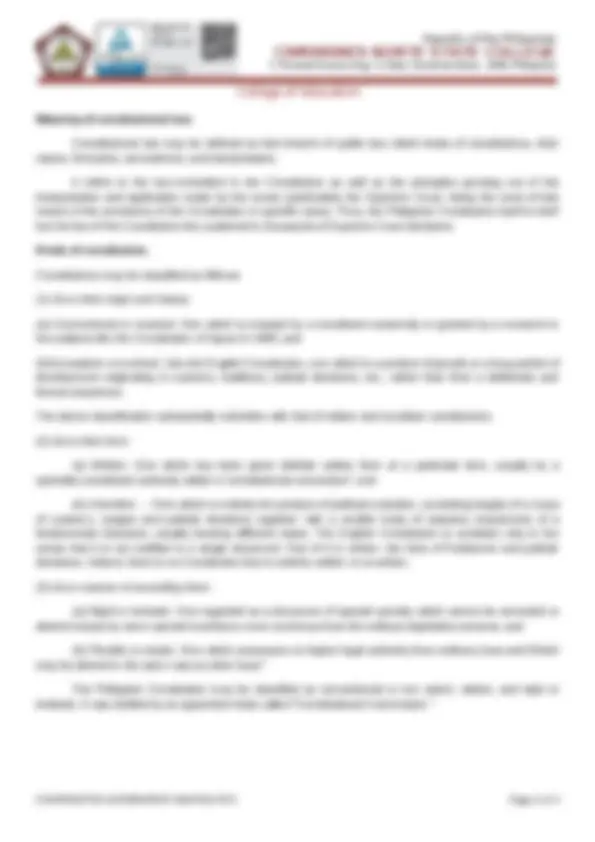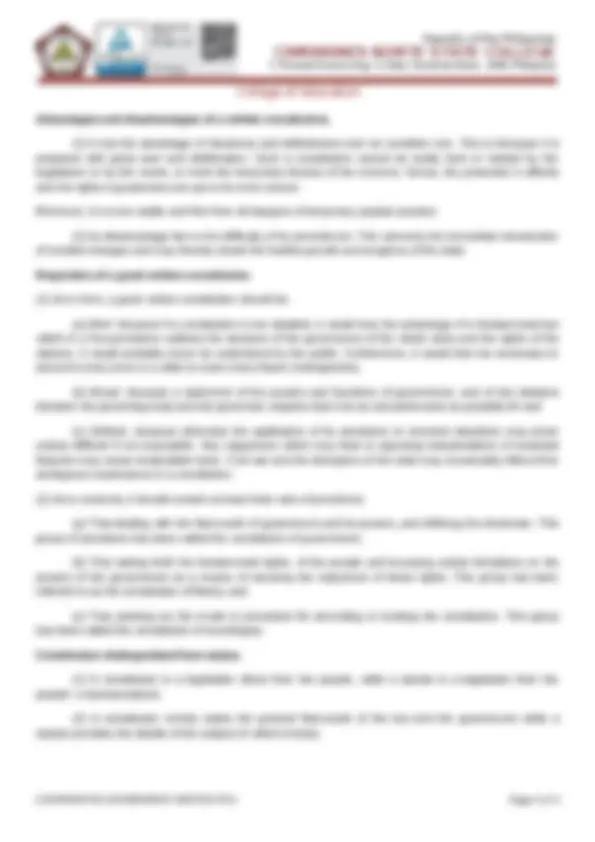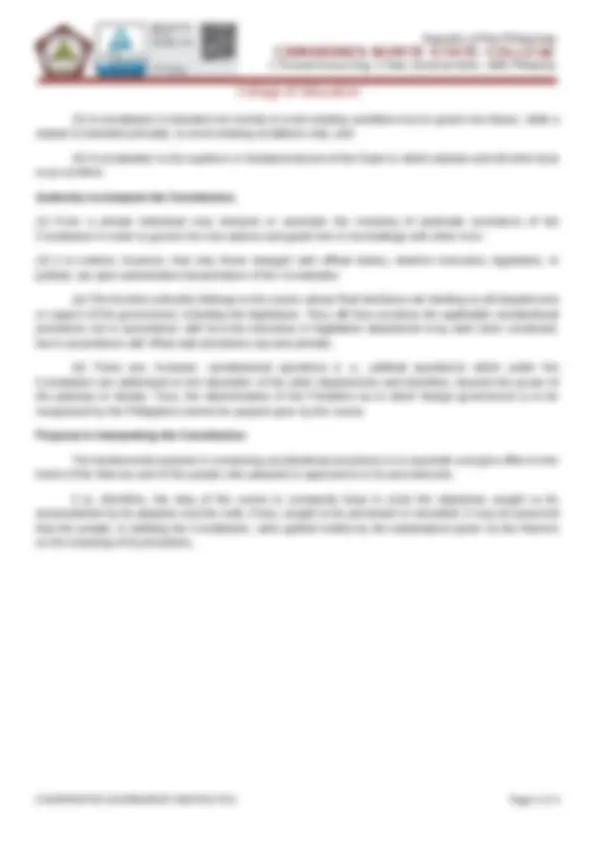





Study with the several resources on Docsity

Earn points by helping other students or get them with a premium plan


Prepare for your exams
Study with the several resources on Docsity

Earn points to download
Earn points by helping other students or get them with a premium plan
Community
Ask the community for help and clear up your study doubts
Discover the best universities in your country according to Docsity users
Free resources
Download our free guides on studying techniques, anxiety management strategies, and thesis advice from Docsity tutors
This are my sample questions exercises and answers it will help you to better known the definitions and more understanding on the topics.
Typology: Exercises
1 / 5

This page cannot be seen from the preview
Don't miss anything!




F. Pimentel Avenue, Brgy. 2, Daet, Camarines Norte – 4600, Philippines COMPARATIVE GOVERNMENT AND POLITICS Period: 2nd Semester AY 2022- Subject Instructor: GINA J. ESTRADA, MAED Course, Yr & Block: Learning Materials: Unit 1 Prelim Rating Period Time Allotment: References: Textbook on the Philippine Constitution by Hector S. De Leon ================================================================================= Lesson 2. Outline of Topics
F. Pimentel Avenue, Brgy. 2, Daet, Camarines Norte – 4600, Philippines (3) As to relationship between the executive and the legislative branches of the government: (a) Parliamentary government or one in which the state confers upon the legislature the power to terminate the tenure of office of the real executive. Under this system, the Cabinet or ministry is immediately and legally responsible to the legislature and mediately or politically responsible to the electorate, While the titular or nominal executive the Chief of State -occupies a position of irresponsibility; and (b) Presidential government or one in which the state makes the executive constitutionally independent of the legislature as regards his tenure and to a large extent as regards his policies and acts, and furnishes him with sufficient powers to prevent the legislature from trenching upon the sphere marked out by the constitution as executive independence and prerogative. On the basis of the above classifications of government, it can be said that the Philippine government is a representative democracy, a unitary and presidential government with separation of powers. It also embodies some aspects of pure democracy such as, for instance, the constitutional provision on initiative and referendum. (see Art. VI, Sec. 32.) Under our Constitution, executive power is vested in the President and the Cabinet, legislative power with the Congress composed of a Senate and a House of Representatives, and judicial power with the Supreme Court and the lower courts. CONCEPT OF CONSTITUTION Meaning of constitution. In its broad sense, the term constitution refers to “that body of rules and principles in accordance with which the powers of sovereignty are regularly exercised. As thus defined, it covers both written and unwritten constitutions. With particular reference to the Constitution 'of the Philippines, it may be defined as that written instrument by which the fundamental powers of the government are established, limited, and defined and by which these powers are distributed among the several departments or branches for their safe and useful exercise for the benefit of the people. Nature and purpose or function of constitution. (1) Serves as the supreme or fundamental law. A constitution is the charter creating the government. It has the status of a supreme or fundamental law as it speaks for the entire people from whom it derives its claim to obedience. It is binding on all individual citizens and all organs 0f the government. It is the law to which all other laws must conform and in accordance with which all private rights must be determined and all public authority administered. It is the test of the legality of all governmental actions, whether proceeding from the highest official or lowest functionary. (2) Establishes basic framework and underlying principles of government. The purpose of a constitution is to prescribe the permanent framework of the system of government and to assign to the different departments or branches, their respective powers and duties, and to establish certain basic principles on which the government is founded. It is primarily designed to preserve and protect the rights of individuals against the arbitrary actions of those in authority. Its function 1s not to legislate in detail but to set limits on the otherwise unlimited power of the legislature.
F. Pimentel Avenue, Brgy. 2, Daet, Camarines Norte – 4600, Philippines Advantages and disadvantages of a written constitution. (1) It has the advantage of clearness and definiteness over an unwritten one. This is because it is prepared with great care and deliberation. Such a constitution cannot be easily bent or twisted by the legislature or by the courts, to meet the temporary fancies of the moment. Hence, the protection it affords and the rights it guarantees are apt to be more secure. Moreover, it is more stable and free from all dangers of temporary popular passion. (2) Its disadvantage lies in the difficulty of its amendment. This 'prevents the immediate introduction of needed changes and may thereby retard the healthy growth and progress of the state. Requisites of a good written constitution. (1) As to form , a good written constitution should be: (a) Brief. because if a constitution is too detailed, it would lose the advantage of a fundamental law which in a few provisions outlines the structure of the government of the whole state and the rights of the citizens. It would probably never be understood by the public. Furthermore, it would then be necessary to amend it every once in a while to cover many future contingencies; (b) Broad. because a statement of the powers and functions of government, and of the relations between the governing body and the governed, requires that it be as comprehensive as possible;44 and (c) Definite. because otherwise the application of its provisions to concrete situations may prove unduly difficult if not impossible. Any vagueness which may lead to opposing interpretations of essential features may cause incalculable harm. Civil war and the disruption of the state may conceivably follow from ambiguous expressions in a constitution. (2) As to contents , it should contain at least three sets of provisions: (a) That dealing with the framework of government and its powers, and defining the electorate. This group of provisions has been called the constitution of government ; (b) That setting forth the fundamental rights. of the people and imposing certain limitations on the powers of the government as a means of securing the enjoyment of these rights. This group has been referred to as the constitution of liberty; and (c) That pointing out the mode or procedure for amending or revising the constitution. This group has been called the constitution of sovereignty. Constitution distinguished from statue. (1) A constitution is a legislation direct from the people, while a statute is a legislation from the people’ s representatives; (2) A constitution merely states the general framework of the law and the government while a statute provides the details of the subject of which it treats;
F. Pimentel Avenue, Brgy. 2, Daet, Camarines Norte – 4600, Philippines (3) A constitution is intended not merely to meet existing conditions but to govern the future, while a statute is intended primarily .to meet existing conditions only; and (4) A constitution is the supreme or fundamental law of the State to which statutes and all other laws must conform. Authority to interpret the Constitution. (1) Even a private individual may interpret or ascertain the meaning of particular provisions of the Constitution in order to govern his own actions and guide him in his dealings with other men. (2) It is evident, however, that only those charged with official duties, whether executive, legislative, or judicial, can give authoritative interpretation of the Constitution. (a) This function primarily belongs to the courts whose final decisions are binding on all departments or organs of the government, including the legislature. They will thus construe the applicable constitutional provisions not in accordance with how the executive or legislative department may want them construed, but in accordance with What said provisions say and provide, (b) There are, however, constitutional questions (i. e., political questions) which under the Constitution are addressed to the discretion of the other departments and therefore, beyond the power of the judiciary to decide. Thus, the determination of the President as to which foreign government is to be recognized by the Philippines cannot be passed upon by the courts. Purpose in interpreting the Constitution. The fundamental purpose in construing constitutional provisions is to ascertain and give effect to the intent of the framers and of the people who adopted or approved it or its amendments. It is, therefore, the duty of the courts to constantly keep in mind the objectives sought to be accomplished by its adoption and the evils, if any, sought to be prevented or remedied. It may be assumed that the people, in ratifying the Constitution, were guided mainly by the explanations given by the framers on the meaning of its provisions.